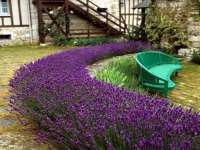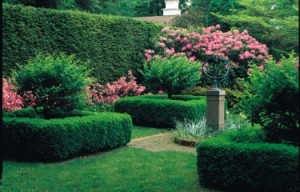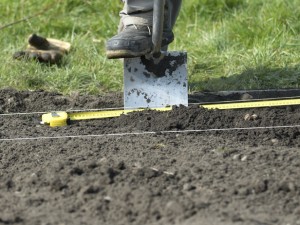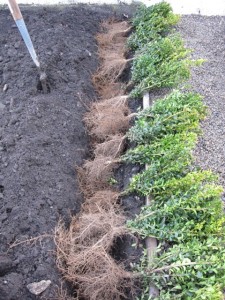 Most trees and shrubs have potential to make hedges.
Most trees and shrubs have potential to make hedges.
Hedging plants are often supplied as bare-root specimens, which are usually inexpensive. However, pot-grown plants are equally suitable but cost a little more.
 Evergreens, especially, are often sold as root-wrapped, where the roots are in a soil ball contained by a fabric casing. This wrapping must be removed, if it is of synthetic fibre, but natural fibre wrappings are sometimes left on.
Evergreens, especially, are often sold as root-wrapped, where the roots are in a soil ball contained by a fabric casing. This wrapping must be removed, if it is of synthetic fibre, but natural fibre wrappings are sometimes left on.
Removal of wrapping is still recommended, though. Small hedge plants are often called whips and are about 60cm (2ft) high. They are very cheap and are easy to establish. Larger plants need more care and are more expensive. It is best to plant whips closely as they not only form a thick hedge, but compete with each other and so reduce the amount of trimming required.
When to plant a hedge
Evergreen and semi-evergreen hedges: Early autumn is ideal for hedging plants such as box, privet (semi-evergreen) and yew. However, they can be planted at any time from late autumn until late winter.
Deciduous hedges: Plant beech, hawthorn and hornbeam any time from leaf fall. This is typically from mid-autumn until late winter.
In all cases, planting is best delayed until the soil can be worked easily, especially if the ground is frozen or waterlogged.
If there is a delay in planting, keep the plants in a frost-free shed and cover their roots with moist straw, paper or potting compost and plastic sheet. This will prevent them drying out. Alternatively, they can be temporarily planted very close together in a trench, with their roots covered in at least 20cm (8in) of soil (this is called heeling-in).
Planting and caring for a new hedge is very similar to that for any new tree or shrub. Good soil preparation beforehand will give your hedge the best start in life.
Soil Preparation
Prepare the ground by digging over a strip 60-90cm (2-3ft) wide and one spit (or spade blade) deep.

If a herbicide (weedkiller) has not been used beforehand, remove all weeds.
Add organic matter, such as garden compost or a proprietary tree and shrub planting mix, spreading it over the soil and mix into top 25cm (10in) of soil with a fork (forking in).
Rake in general-purpose fertiliser, such as Growmore at 70g per sq m (2oz per sq yd).
Soils that become waterlogged in winter may require a permanent drainage system. Alternatively, form the soil into a ridge about 15-20cm (6-8in) high and 50-70cm (20-28in) across to plant into.
Planting

Planting distances vary from 30-60cm (1-2ft), depending on the plants’ final size, the size of hedge required and plant vigour. For hedges thicker than 90cm (3ft), plant a staggered double row 45cm (18in) apart, with plants 90cm (3ft) apart.
Trim back damaged roots to healthy growth with sharp knife or old pair of secateurs.
Spread out the roots, ensuring the planting depth is correct (note that the previous soil mark on the stem indicates how deeply the plants were grown in the nursery or pot).
Work soil between the roots, firm plants in so that soil is in close contact with the roots. Water if the soil is dry.
Mulch to a depth of 7.5cm (3in) after planting to prevent weeds.
Ensure plants are well-watered during dry spells for the next two years.
Top-dress annually with a general-purpose fertiliser, such as Growmore at 70g per sq m (2oz per sq yd), and re-apply mulch as required.
Keep the hedge and 45cm (18in) on each side weed free.
Problems
Hedges might take three to seven years to attain their desired size. You can buy semi-mature hedges which, although costly, will give an instant hedge. Semi-mature plants require extra care in planting and watering.
Hedges might need shelter in their initial years on exposed sites.
